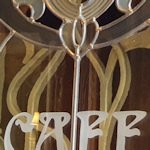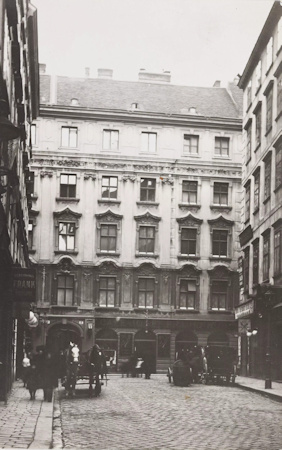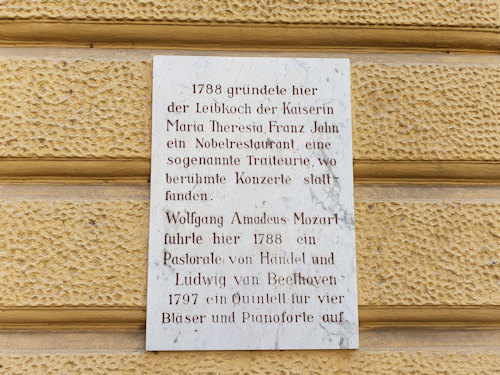
When they say Vienna has a long history of coffee house culture, they mean really long. Café Frauenhuber, for example, soon celebrates its 200 year anniversary in a building that’s over 300 years old.
As you can imagine, the word “traditional” certainly applies to this café tucked away in the midst of the old town.
- First opened in 1824
- The building dates back to 1720
- Café Frauenhuber’s predecessor hosted Mozart and Beethoven
- See also:
Mozart, Beethoven, and coffee

(A small seated area appears outside in the warmer seasons)
Café Frauenhuber first started serving coffee in 1824. To put that in perspective, Thomas Jefferson was still alive at the time. As was Beethoven (more on him later).
The house and location go back even further than the coffee house, though: the buildings lining the street outside make the nearby State Opera House (built in 1869) look like a mere baby.
The café, for example, sits on the ground floor of house number 6, which went up around 1720 on a site in use since at least the early 1300s.
Café Frauenhuber’s immediate neighbour at number 8 has its own particular claim to fame, being the former 17th/18th century palatial townhouse of Prince Eugene, defender of the Habsburg dominions and builder of Belvedere (home to all those Klimt paintings).
Eugene’s Winterpalais now houses the Finance Ministry; their offices extend into the premises above the coffee house.

(Café Frauenhuber in the early 1900s as seen from Rauhensteingasse, taken from a postcard produced by Verlag Reinhold Entzmann & Sohn; Wien Museum Inv.-Nr. 143857; excerpt reproduced with permission under the terms of the CC0 licence)
Not that number 6 need be shy about its own history. A plaque outside lets visitors know that a couple of adopted sons of Vienna once showed off their musical talents inside the building. My rough translation:
In 1788, Franz Jahn, the personal chef of Empress Maria Theresa, established a luxury restaurant (a so-called traiteurie) here which hosted famous concerts. Wolfgang Amadeus Mozart performed a piece of pastoral music by Handel in 1788, while Ludwig van Beethoven premiered a quintet for pianoforte and brass in 1797.
Both of those famous names appeared more than once in Jahn’s establishment. (If you want to indulge in more Mozart, the Mozarthaus is just a few streets away up toward the cathedral.)
But what of today’s Café Frauenhuber?
Inside is a slightly eccentric mix of styles that owes much to the age of the establishment.

(The plaque revealing the musical heritage)
The white vaulted ceiling with its thick arches contrasts with the red upholstery, wooden bentwood-style chairs and hardwood hat stands. A brass lantern sits close to a glass chandelier. And what looks like an art deco stained glass installation looks down over the stairs to the toilets.
This all gives Café Frauenhuber an unaffected air to go with its aura of unhurried timelessness. Smart but not pristine, like an old gentlemen who never seems to age (or rush), still playing whist with a sharp mind and wearing a tie and jacket.
The menu is about as traditional as they come. In fact, if you’ve missed out on a typical Viennese dish, this is your chance to catch up on the likes of Kaiserschmarrn, apple strudel, Schnitzel, sausages and Serviettenknödel.
My breakfast was rather fine, the butter scoring a promising 8.5/10 on the spreadability index. The jam arrived in a glass jar marked with a handwritten label of the kind your grandmother might stick on her homemade produce. A nice touch, I must say (excellent jam, too).
Oh, and my melange coffee was lovely and creamy.
Getting to Café Frauenhuber
Given its age, you won’t be surprised to find Café Frauenhuber right in the middle of the old town, tucked away from tram lines and traffic-filled ring roads. It’s just off one of the main pedestrianised streets that lead away from Stephansplatz square and the cathedral.
Subway: take the U3 or U1 lines to Stephansplatz station and exit onto Kärntner Straße.
Tram/bus: the trams around the Ring take you within a stroll of Himmelpfortgasse. Take the 2 to Weihburggasse, for example. Or the 1, 2, 62, 71 or D to Oper/Karlsplatz.
Or just find your way there as you wander through the centre.
Address: Himmelpfortgasse 6, 1010 Vienna | Website